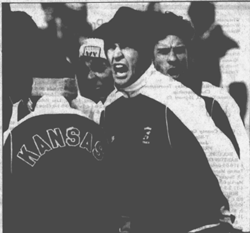LAWRENCE, Kan. (AP) - Rows of markers at the indoor track complex at Anschutz Pavilion testify to the glory days of track and field at the University of Kansas.
Each marker represents one of the 75 Big Eight championships and 17 national championships the Jayhawks have won over the years in track and cross country. The last one, the Big Eight indoor track championship, came in 1983.
There was a time when thousands of people came to the Kansas Relays each spring.
And there was a time when Kansans like Glenn Cunningham, Wes Santee and Jim Ryun led the Jayhawks in national championship competition against other major track powers like UCLA, Oregon and Southern Cal.
Those times appear to be gone. Though running as a participation sport has swept the nation, interest in track has dropped dramatically.
A recent issue of Track & Field News, which bills itself as "the bible of the sport," featured the theme, "What if they gave a track meet and nobody came?"
It's about that bad.
"We used to have a great dual meet with UCLA," said Bob Timmons, head track coach at Kansas from 1964 to 1988. "But the last time we went there, I counted the crowd. There were less than 200 people."
Also, in recent years American collegiate track competition has increasingly been dominated by international athletes.
"When Texas has a competition against the University of Texas-El Paso, you rarely have Texans competing," said Harley Lewis, assistant director of championships for the NCAA at its Overland Park headquarters.
Track faces the same problems as other traditional Olympic sports, most of which are individual sports, Lewis said.
"This country right now has a love affair with team sports," he said.
And the NCAA is part of the problem, some critics say.
For example, the NCAA restricts Division I schools to 14 scholarships for men and 16 for women. Those numbers soon will be cut further.
"When I came to Kansas, there were no limits on scholarships," Timmons said. "Then scholarships were cut to 26, then 23."
A substantial reduction in scholarships was part of a cost-containment effort that affected all NCAA-sponsored sports, Lewis said.
The reductions are not necessarily a cause, but they have coincided with the decline of Kansas as a track and cross-country power and with reduced interest in the sport as a whole.
Scholarship limits make it difficult to field competitive teams because of the many events in track.
And many coaches choose to recruit experienced international athletes rather than take a chance of an 18-year-old American.
"Reducing scholarships could well increase the use of foreign athletes," said Gary Schwartz, a former Kansas athlete who became head track coach there after Timmons retired. "Some coaches think it's so important to win that they will go for foreign athletes."
Track also lost a lot of fan interest when it switched to the metric system, Timmons said.
"The object used to be to break four minutes for the mile," he said. "Everybody relates to the mile, but who relates to 1,500 meters?"
Schwartz also is head of the NCAA Division I Track and Field Coaches Association. The coaches are organizing themselves to fight what they see as a lack of opportunity to influence policies that affect them, he said.
"The biggest frustration is the feeling that we did not have enough input into the process of making the rules," Schwartz said. "Now we have to spend a lot of time `fine-tuning' - that's the NCAA's word."
Lewis said the organization's policies are set by the member colleges through the national convention. "The NCAA works in a very democratic process," he said.
There are no easy answers to reviving public interest in track, Timmons said. But one approach might be for all colleges to include sports in their general budgets.
"What if sports were built into the college budget, not the athletic department budget?" Timmons said. "If athletics have educational value, why should football pay expenses for track? The NCAA wants the university president to be responsible for the athletic program, then why not be responsible for the budget?"
And some say the sport needs to emphasize team competition.
"Dual meets have almost been dropped because of the elitism required to get to the NCAA meet," Lewis said. "Squads have been reduced to a few kids, and they couldn't compete in all events. Meets have been reduced to non-scoring competition."
Scholarship limits may be here to stay because of money shortages, but Timmons said he favors letting each college decide how many scholarships to give each sport within some overall limit.
He pointed out that Big Eight schools like Oklahoma State and Iowa State have a great wrestling tradition. "When you limit Oklahoma State's wrestling program, you build equity among schools but you also destroy a great program," Timmons said.
"Leave out football and basketball, but take the other sports and give the schools a certain number of scholarhips and let the schools decide where to use them."
But Lewis said the NCAA was unlikely to adopt such a plan.
"Schools tend to prefer a level playing field," he said. "They vote those kind of things in as a group."
Copyright 1991 by The Associated Press. All rights reserved.
